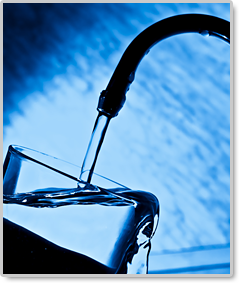Options for Filtering Your Tap Water

WHY SHOULD YOU FILTER YOUR WATER?
Our modern society seems to produce no shortage of ways to contaminate our drinking water: improperly disposed of chemicals; leaking landfills; deteriorating water distribution pipes; stormwater runoff carrying hazardous chemicals and animal wastes; terrorism risks; and more. Filtering the water in your home provides benefits in four ways:
-
Chemical:
Water filters are designed to remove hazardous chemicals from your water. Chemicals in your water, such as chlorine and chlorine byproducts, can increase your risk of rectal cancer, colon cancer, and bladder cancer. -
Bacteriological:
Removing biological contaminants, such as cryptosporidium and giardia, from your drinking water can significantly reduce your risk of gastrointestinal diseases. -
Taste
: Removing contaminants from your drinking water can also help improve the taste of your water. -
Cost
: And filtering the water for your home can help you save money in two ways: 1) it can beat the cost of purchasing individual bottles of water from the store; and 2) by making the water in your home taste better, it can become an alternative to consuming more costly beverages.
PRO'S AND CON'S OF 6 ALTERNATIVES
Below we compare 6 different ways for filtering the water for your home: faucet-mounted; pitcher filters; hand-held personal filters; water coolers (bottled); water coolers (“bottle-less”); and whole-house filters. For each of these methods, we compare their costs, whether installing them is a "do-it-yourself" job, how long they can go between filter changes, how they work, and their pro's and con's.
Faucet-Mounted
Let’s start first with "faucet-mounted" style water filters. This type of filter attaches to the end of the faucet by unscrewing the aerator and replacing it with the filter and valve unit. Depending on the model, these can cost between $20 and $100 for the device, and about $20 per year for filters. They can filter between 100 and 200 gallons before the filter needs to be replaced (depending on the quality of the water that you have). And it is a fairly easy do-it-yourself job to install one of these units.
The advantages of faucet-mounted filters are that they are easy to install and fairly inexpensive (see costs and reviews of faucet-mounted filters). Some of the negative aspects to faucet-mounted filters are that certain styles can interfere with the normal use of the sink; and because the units are small in size, the filters need to be changed every 2-3 months.
Pitcher Filters
Next, let’s look at the pitcher-style water filters. This type of filter is located in the top of a pitcher, which removes impurity from the water when the water is poured into the pitcher. These pitcher filters can cost between $10 and $45, and about $35 per year for replacement filters. And you can filter about 40 gallons before the filter needs to be replaced, which is a do-it-yourself job.
The advantages of pitcher-style water filters are that they are fairly inexpensive, and in addition to filtering the water, it also gives it to you cold from the refrigerator (see costs and reviews of pitcher-style water filters). Some of the negative aspects of this style of filtering include that the volume of water is limited to one pitcher at a time; and if the pitcher is low or empty, then you have to wait for cold water. And since the units are small, you have to change the filters about every 2-3 months.
Hand-Held Personal Filters
Next, let’s look at “hand-held” personal water filters. With this type of water filter, the filter is located in the top of an 8-12 ounce water bottle. You fill the bottle with water, and then the water is filtered as you drink from it. These hand-held water filters can cost between $11 and $15, and replacement filters run about $25 per year. They can filter about 30-35 gallons per filter, and this is a do-it-yourself job.
The advantages of this style of water filter are that you can take it with you and filter publicly-available water wherever you go. The downside is that it is designed for personal use, and since they are small, the filter needs to be changed every 2-3 months.
Water Cooler (bottled)
Next, let’s look at bottled water coolers. This type of water dispenser allows 5-gallon jugs of pre-filtered water to be placed on top, which feeds a reservoir where the water is cooled. And some units have heaters for dispensing hot water too. Many water suppliers will give you a dispenser to use when you are purchasing their water, and the cost of the filtered water varies, but can run about $100 per year for comparison purposes. Replacing the water bottles is a do-it-yourself task, but lifting the 5-gallon bottles of water can be difficult for some people (see costs and reviews of filtered water coolers).
The advantages of this type of water filtering include that it does not require any changes to the plumbing in your home, and the dispenser can often be provided by the water supply company. The disadvantages of this approach include that it requires water jug deliveries on a regular basis, and as mentioned earlier, some people have problems lifting the 5-gallon bottles onto the top of the dispenser.
Water Cooler ("Bottle-less")
Next, let’s look at “bottle-less” water coolers. A bottle-less water cooler connects to your home’s plumbing system, and the dispenser unit filters and cools the water. And some dispensers also have a heater for dispensing hot water. A bottle-less water cooler can cost between $300 and $800, depending on the style of unit, plus it can require $300 to $600 for installation, depending on how accessible your existing plumbing is. Filters can run about $40 per year, and filter about 3,500 gallons each. This is not a do-it-yourself job for most people, since you need a qualified plumber to connect the unit to your home’s water supply.
The advantages of a bottle-less water cooler are that it does not require jugs of water to be delivered to your home, and the large filters do not have to be changed as often. However, they require the cost of a plumber to install the unit, and for some homes, there may be limited access to connecting to plumbing where the unit is desired to be placed.
Whole-House Filters
And finally, there are "whole-house" water filters. A whole-house water filter is installed by cutting into the main water supply of your home and placing the filter system so that all of your water goes through it (see types, costs, and reviews of whole-house water filters). A whole-house filter can run between $300 and $800, depending on the style that you choose, and replacement filters can run about $100 per year, and depending on the model, it can filter between 40,000 and 100,000 gallons per filter. This is definitely not a typical do-it-yourself job for most people, as you need a qualified plumber for cutting the system into your main water supply.
The advantages of a whole-house water filter system are that it filters the water for your entire house, and because of the larger space where the filter is installed, large, very effective filters can be used. The downside of a whole-house filter is that they are expensive.
In addition, whole-house water filters can also remove chlorine from the hot water supplied to your showers. Chlorine absorption into your family's skin and lungs in a hot shower is actually more dangerous than from drinking the water.
Related Articles . . .
Avoiding Common Plumbing Problems
Plumbing problems can range from minor visible nuisances, to hidden troubles that can be causing major damage to your home and your family’s health. This article discusses how to avoid common plumbing problems.
Bathroom Makeover Ideas
Here are ideas for making over your bathroom that will add new features, save energy and water, improve health and safety, make it more beautiful, and help better meet the special needs of the elderly.
Well Water Safety: DO's and DON'Ts
If your home uses well water, then there are some very important things you need to know and do, that will help keep your water safe for you and your family. This article covers the do's and don'ts, and other considerations.
What NOT to Do If You Have a Septic System
Replacing a septic system can cost tens of thousands of dollars, and having to frequently pump your tank gets expensive too. To avoid these costs, here is what you should NOT do if you have a septic system.








